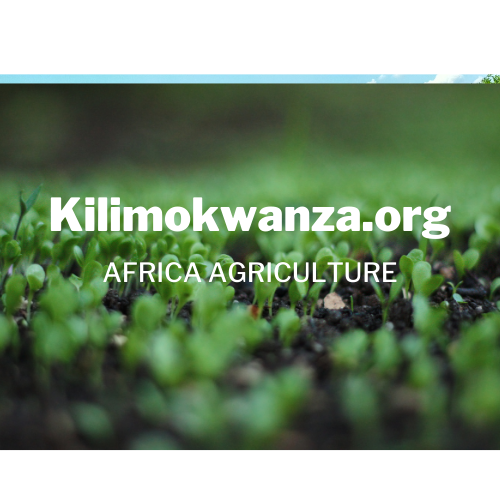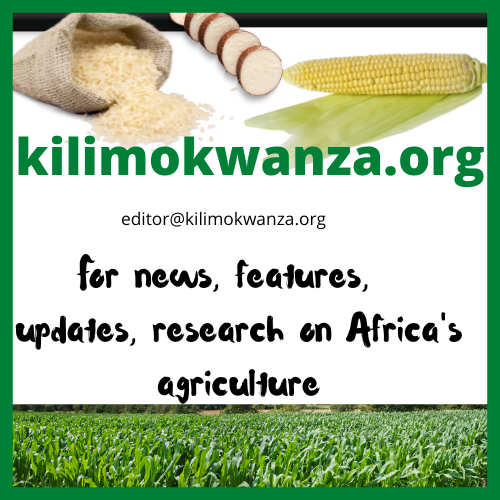Farmers’ Assessment of sorghum varieties in Central Tanzania in 2013 cropping season
United Republic of Tanzania
Ministry of Agriculture, Food Security and Cooperatives
Directorate of Research and Training
The Northern Zone Agricultural Research and Development Institute (NZARDI)
Farmers’ Assessment of sorghum varieties in Central Tanzania in 2013 cropping season
By:
P. Sulumo and F. Mgonja
May 2013
Selian Agricultural Research Institute (SARI)
P.O. Box 6024 Arusha Tanzania
Farmers Assessment of sorghum hybrid varieties/lines at Ikhanoda village in Singida Rural District, Singida Region, Central Tanzania in 2013 crop season
1.0 Introduction:
There are several factors and interactions that may contribute to low yields such as genetic potential of the used varieties, types and levels of management, environmental factors, moisture availability, soil fertility etc. Variety preference does not however, depend solely on the yield potential alone but, also on the socio-economic circumstances of the farmers and other stakeholders like the urban dwellers who are the major users of these products, raw material for industrial uses e.g. beer production such as eagle brand. Variety characteristics or quality such as early maturity, disease/pest tolerance, drought tolerance, marketability, white grains, plant medium height for easiness of bird scaring are also some of the criteria considered by poor resource farmers who grow sorghum crop to improve food and cash availability for the households.
To ensure that technologies released address end users’ needs farmers must be involved in technology development and evaluation/assessment. Farmers’ participation in the evaluation will ensure faster awareness, acceptance and adoption of the released technologies. Farmers use their own Indigenous Knowledge and criteria to assess technologies and in most cases their criteria are not the same as the researchers’ criteria.
For any variety/technology acceptance or rejection it is their criteria, which is used to assess it at the end of the season. It is therefore very important to know farmers criteria in order to develop technologies, which will meet their needs and also be adopted faster by them.
Based on the above mentioned reasons some Farmer Managed Farmer implemented (FMFI) trials were conducted to assess the performance of elite varieties in their own environments and socio-economic circumstances in order to determine their criteria for preference as well as preferred varieties.
2.0 Methodology
Farmers’ assessment of the sorghum varieties/lines was done by SARI scientists from Farming System Socio-Economics Department and Sorghum Program of the Northern Zone in collaboration with Singida Rural districts extension staff and farmers at Mr. Zephania Msengi of Iknanoda village in Singida Rural district on 18th May 2013. A total of five sorghum varieties/lines were assessed i.e. four (4) improved new varieties/lines and one (1) local check.. The assessed four (4) new varieties were ICSA 15xMacia, ICSA2xMacia, ATXx623xMacia, Macia and one (1) Local variety by the name of Langalanga was used as a check variety.
Twenty one (21) farmers from Ikhanoda and Ngamu villages of Singida Rural district and 2 village extensionists plus one from Singida Rural district headquarter participated in the assessment session. Among those who participated, seven (7) of them were women. The farmers who participated had been seeing these trials in their area plus the field day conducted this season.
Initially the farmers were asked to observe the varieties/lines in the field before assessing them. Thereafter the varieties/lines were evaluated using absolute, matrix and pair wise rankings.
3.0 Main objective for the assessment
- Identify farmers’ criteria for sorghum preference
- Identify ICRISAT sorghum varieties/lines preferred by farmers for food and beer brewing
- Release improved sorghum variety for the sorghum growing communities
- Increased sorghum production in Tanzania by using improved ICRISAT sorghum varieties
- Improve household food security and income
- Improves livestock feeding through the use of sorghum crop residues
- Increase industrial raw material from sorghum for beer production like the eagle brand
4.0 Uses and purposes of growing sorghum in Ikhanoda village, Singida Rural district in
Central Tanzania 2013 cropping season
Farmers were asked to narrate the uses/benefit/purposes of growing maize. Table 1 summarizes the uses/benefit of growing maize in Central Tanzania
Table 1 Main uses or importance of growing sorghum in Ikhanoda village, Singida Rural
District in Central Tanzania in 2013 cropping season
| No | Uses/importance | Rank |
| 1 | Food consumption- ugali, porridge, kande and togwa by 70 % | 1 |
| 2 | Cash 30 % | 2 |
| 3 | Livestock feed (crop residues, grains) | 3 |
| 4 | Local brew like mtukuru | 4 |
| 5 | Stalks – source of fuel and temporary fence | 5 |
| 6 | Stems are sweet like those of sugarcane and are therefore consumed | 7 |
| 7 | Ash from cow dung and sorghum stalks is used against storage pests | 6 |
4.1 Food
Sorghum is used mainly as food in most parts of Singida Region in Central Tanzania by about
70 % whereas other food crops like maize, cassava, finger millet and others cover the rest of
the percentage.
4.2 Sources of household income when sold – cash
Sorghum is for cash by about 30 % of the people who are farming sorghum. It’s sold in
local market within their localities and in the region at present
4.3 Local brew making
Local brew as a refreshment to the people is made out of sorghum.
Some of the made local brew brands includes “mtukuru”.
4.4 Livestock feed
Sorghum crop residues, sorghum grains are other major supplementary feed sources apart
from the local/improved grass pastures as a major livestock feed..
4.5 Stalks – Source of fuel and temporary fence
Stems are a good source of fuel after harvesting in areas where there is shortage of
firewood plus making temporary fences near homesteads.
4.6 Stalks consumed as sugarcane
Fully mature sorghum stalks when green especially some local varieties like goose necked types
are as sweet as sugarcane and are chewed by people to get the sweet juice out of it.
4.7 Ash for crop preservation in store
Mixture of cow dung plus sorghum stalks ash is used to preserve grains against storage pests.
5.0: Absolute ranking
Farmers were requested to rank the sorghum varieties they grew according to their preference. Table 2 shows the results.
Table 2: Absolute ranking of sorghum hybrid varieties/lines at Ikhanoda village, Singida
Rural District in Central Tanzania in 2013 cropping season
| No | Varieties/lines | Rank |
| 1 | ICSA 15xMacia | 4 |
| 2 | ICSA2xMacia | 2 |
| 3 | ATXx623xMacia | 1 |
| 4 | Macia | 3 |
| 5 | Langalanga | 5 |
In absolute ranking, ATXx623xMacia ranked number followed by ICSA2Macia as number two, Macia number three and ICSA15xMacia as number four. Langalanga a local variety ranked number five and last
6.0 Characteristics of sorghum varieties/lines as indicated by the farmers
Farmers listed the characteristics of each sorghum varieties/lines as observed in the field at Ikhanda village in Singida district using experience they have or observation they made as indicated below in Table 3
Table 3: Farmers’ description of the sorghum hybrid varieties/lines evaluated at Ikhanoda
village, Singida Rural district in Central Tanzania in 2013 cropping season
| ICSA15xMacia Early maturing Reasonably medium height Moderate/fair strong stalks Moderate/fair tolerance to lodging Moderate/fair heads Brown grains/good market Moderate/fair tolerant to drought High yield Good taste Moderate/fair disease tolerance | ICSA2xMacia Early maturing Reasonably medium height Strong stalks Highly tolerant to lodging Large heads White grains/good market High tolerance to drought Very high yielding Good taste Moderate/fair disease tolerance |
| ATXx623xMacia Early maturing Reasonably medium height Strong stalks Highly tolerant to lodging Large heads White grains/good market High tolerance to drought Very high yielding Good taste Good disease tolerance | Macia Very early maturing Reasonably medium height Strong stalks Highly tolerant to lodging Large heads White grains/good market Drought tolerant High yielding Good taste Moderate/fair disease tolerance |
| Langalanga Very late maturing Tall plants Strong stalks Poor tolerance to lodging Large heads White grains/good market Poor tolerance to drought Moderate/fair yields Good taste Poor disease tolerance |
7.0 Farmers criteria for selecting sorghum varieties/lines in 2013
Farmers mentioned the criteria they use to select maize varieties/lines as shown in
Table 4.
Table 4: Important criteria used by farmers to select sorghum hybrid varieties/lines in
Ikhanoda village, Singida Rural District in Central Tasnzania in 2013 cropping season
| No | Criteria | Rank |
| 1 | High yield | 1 |
| 2 | Early maturity | 2 |
| 3 | Drought tolerance | 4 |
| 4 | Disease tolerance | 3 |
| 5 | Good market/white grains | 6 |
| 6 | Strong stalk/medium height | 7 |
| 7 | Tolerance to lodging | 8 |
| 8 | Palatability | 5 |
The most important farmers’ criteria for sorghum variety/line preference were high yield, early maturity, disease tolerance, drought tolerance, palatability, good market/white grains, strong stalks/medium height and tolerance to lodging.
The seven most important ones were used in the next step of matrix ranking where these criterions were scored for each lines/varieties tested. Tolerance to lodging was left in this assessment because strong stalks/medium height has taken care of it.
8.0 Matrix ranking
Farmers conducted a matrix ranking of the eight sorghum varieties/lines as indicated in Table 5.
Table 5: Matrix ranking of sorghum hybrid varieties/lines at Ikhanoda village, Singida
Rural District in Central Tanzania 2013 cropping season
,
| No | Criteria | Sorghum varieties/lines | Total | Rank | ||||
| ICSA 15xMacia | ICSA2xMacia | ATXx623xMacia | Macia | Langalanga | ||||
| 1 | High yield | 4 | 5 | 5 | 4 | 3 | 21 | 3 |
| 2 | Early maturity | 5 | 5 | 4 | 5 | 1 | 20 | 4 |
| 3 | Disease tolerance | 3 | 3 | 4 | 3 | 2 | 15 | 7 |
| 4 | Drought tolerance | 4 | 4 | 5 | 4 | 2 | 19 | 6 |
| 5 | Grain colour/good market | 4 | 4 | 5 | 4 | 5 | 22 | 1 |
| 6 | Strong stalk/Medium height | 3 | 5 | 5 | 5 | 2 | 20 | 4 |
| 7 | Palatability | 4 | 4 | 4 | 5 | 5 | 22 | 1 |
| Total | 27 | 30 | 32 | 30 | 20 | |||
| Rank | 4 | 2 | 1 | 2 | 5 |
Key for scores: 1 = Very poor, 2 = Poor, 3 = Moderate/fair, 4 = Good and 5 = Very good
ATXx623xMacia scored very good in most criterions to good in disease tolerance, early maturity and palatability, ICSA2xMacia has moderate/fair scores for disease tolerance, good for drought tolerance, grain colour/good market and palatability, while very good is for high yield, early maturity and strong stalk/medium height. ICSA15xMacia has early maturity scored as very good, high yield, grain colour/good market, palatability all scoring good while moderate/fair is for strong stalk/medium height and disease tolerance criterions. Langalanga has many criteria scoring poor, early maturity as very poor, high yield as moderate/fair and grain colour/good market and palatability all scoring very good
The highest scored criterions were grain colour/good market and palatability an indication that many of these tested sorghum varieties/lines were good in those criterions, followed by high yield, strong stalks/medium height, early maturity and drought tolerance.
The least scored characteristic was disease tolerance indicating that the sorghum varieties/lines differ in that main criterion.
Across all criteria in matrix ranking ATXx623xMacia ranked number one, both ICSA2 and Macia all ranked number two in matrix ranking but were number two and three in absolute ranking respectively. ICSA15xMacia and Langalanga ranked number four and five as also being ranked in absolute ranking respectively.
9.0 Pair wise ranking
The farmers did a pair wise ranking as shown in Table 6.
Table 6: Pair wise ranking of sorghum hybrid varieties/lines at Ikhanoda village, Singida
Rural District in Central Tanzania 2013 cropping season
| ICSA15xMacia | ICSA2xMacia | ATXx623xMacia | Macia | Langalanga | Total | Rank | |
| ICSA15xMacia | xxxx | ICSA2xMacia | ATXx623xMacia | Macia | ICSA15xMacia | 1 | 4 |
| ICSA2xMacia | xxxx | ATXx623xMacia | ICSA2xMacia | ICSA2xMacia | 3 | 2 | |
| ATXx623xMacia | xxxx | ATXx623xMacia | ATXx623xMacia | 4 | 1 | ||
| Macia | xxxx | Macia | 2 | 3 | |||
| Langalanga | xxxxx | 0 | 5 |
In pair wise ranking, trend of results were the same as those of absolute and matrix for ATXx623xMacia, ICSA2xMacia, ICS15xMacia and Langalanga as number one, two, four and five respectively. Macia ranked third in pair wise and absolute but number two in matrix together with ICSA2xMacia.
9.0 Conclusions
· ATXx623xMacia, ICSA2xMacia, Macia and ICSA15xMacia were most preferred varieties in absolute, matrix and pair wise rankings as first, second, third and fourth respectively.
· Langalanga the local variety ranked fifth and last was the least preferred in all rankings
· Based on farmers preferences as shown in all rankings new lines ATXx623xMacia, ICSA2xMacia and ICSA15xMacia should be considered for release.
10.0: Acknowledgment.
The Principal Investigator would like to gratefully acknowledge the financial and technical support provided by HOPE/ICRISAT Programme based in Nairobi Kenya, to carry out this study.
We would also like to thank the Zonal Director (NZARDI) for allowing the SARI staff to undertake the study.
The great collaboration received from the Iramba District Extension Services team is highly appreciated.
Lastly we highly acknowledge the active participation, commitment and keen interest shown by all our beloved farmers in all the villages we worked with in Iramba District, Singida Region. We are looking forward to work with them again.
11.0: Appendix
Panicles physical characteristics/grain colour and list of participants in the assessment session are found below in Appendix 1 and Appendix 2 respectively.
Appendix 1: Some physical characteristics of panicles for 5 sorghum hybrid varieties/lines
that were assessed in 2013 cropping season
| No | Sorghum variety/linei | Panicle shape | Panicle size | Grain colour |
| 1 | ICSA 15xMacia | Closed | Medium | White |
| 2 | ICSA2xMacia | Open | Large | Khaki |
| 3 | ATXx623xMacia | Closed | Medium/large | Light brown |
| 4 | Macia | Open | Large | White |
| 5 | Langalanga | Closed | Small | Brown |
Appendix 2: Sorghum and finger millet farmers assessment participants in Singida Rural
District 17th May 2013
| No | Farmers Name | Village | Gender |
| 1 | Jacob Musa | Ikhanoda | Male |
| 2 | Eldens Athmani | -do- | Male |
| 3 | Tonna Athmani | -do- | Male |
| 4 | Elfuraha Petro | -do- | Male |
| 5 | Zefania Ntenga | -do- | Male |
| 6 | Raphael Jacob | -do- | Male |
| 7 | Mohamed Salum | -do- | Male |
| 8 | Jonas Omari | -do- | Male |
| 9 | Fatuma Ramadhani | -do- | Female |
| 10 | Winfrida Ismail | -do- | Female |
| 11 | Habiba Ramadhani | -do- | Female |
| 12 | Elmery Ahmedi | -do- | Female |
| 13 | Ismail Ntandu | Ngamu | Male |
| 14 | Sofia Ramadhani | -do- | Female |
| 15 | Amina Salum | -do- | Female |
| 16 | Elias Ntandu | -do- | Male |
| 17 | Hamisi Lyimo | -do- | Male |
| 18 | Vincent Petro | -do- | Male |
| 19 | Athmani Nkasa | -do- | Male |
| 20 | Pili Maulidi | -do- | Female |
| 21 | Shabani Athmani | -do- | Male |
,


